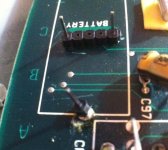Oscar
Experienced Member
Hi,
I think I've read all the M24 posts but could not quite get to my problem.
I bought a M24 (as I really liked them back then) and:
- had to unplug the hard drive as it clearly had crashed, rattling noise.
- on powerup: no video (but you hear the monitor come on), no beep, keyboard LEDs light up for half a second, then start rapidly blinking forever. Until you press reset and it all starts over.
I reseated chips, checked voltages, cleaned contacts to the riser board. Removed hard disk adapter card too. Nothing changes.
The nicad battery looked good and still gave 3.7 volts, I removed it just to be safe.
--> Am I correct in thinking that removing it will not hinder the boot process? It's just a RTC?
The dip switches and jumpers are all normal as per the manual (except the point below) and the seller told me he had not messed with it, it had booted right up the day before to the point where the hard disk obviously did not work. So sudden death.
--> Only question: dipSW 1, #7: this should be ON for mono 80x25, but it's set to OFF for 80x25 color according to the tech manual. That was how the system worked before, and changing it does not change my problem. Should it be on or off, really? For a mono monitor with - I guess - grey scale?
I remember once reading 'rapidly blinking LEDs' means stumbling at the very first hurdle in the boot process, but could not find anything to confirm that anymore.
--> Any hints on where to start looking? What is blinking the LEDs, the CPU or something lower-level?
Any hints welcome!
Regards,
Oscar
I think I've read all the M24 posts but could not quite get to my problem.
I bought a M24 (as I really liked them back then) and:
- had to unplug the hard drive as it clearly had crashed, rattling noise.
- on powerup: no video (but you hear the monitor come on), no beep, keyboard LEDs light up for half a second, then start rapidly blinking forever. Until you press reset and it all starts over.
I reseated chips, checked voltages, cleaned contacts to the riser board. Removed hard disk adapter card too. Nothing changes.
The nicad battery looked good and still gave 3.7 volts, I removed it just to be safe.
--> Am I correct in thinking that removing it will not hinder the boot process? It's just a RTC?
The dip switches and jumpers are all normal as per the manual (except the point below) and the seller told me he had not messed with it, it had booted right up the day before to the point where the hard disk obviously did not work. So sudden death.
--> Only question: dipSW 1, #7: this should be ON for mono 80x25, but it's set to OFF for 80x25 color according to the tech manual. That was how the system worked before, and changing it does not change my problem. Should it be on or off, really? For a mono monitor with - I guess - grey scale?
I remember once reading 'rapidly blinking LEDs' means stumbling at the very first hurdle in the boot process, but could not find anything to confirm that anymore.
--> Any hints on where to start looking? What is blinking the LEDs, the CPU or something lower-level?
Any hints welcome!
Regards,
Oscar

